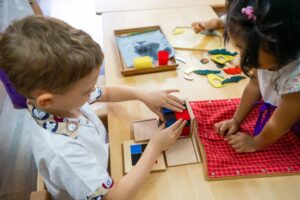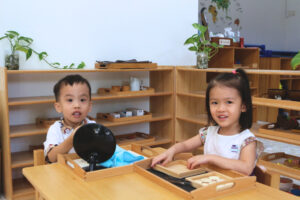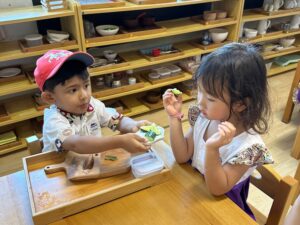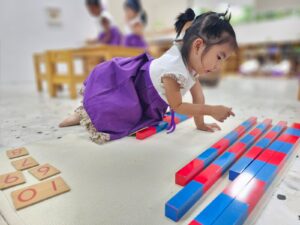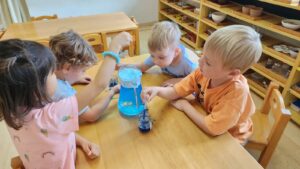At House on the Hill, we believe that teaching healthy eating to preschoolers is just as important as reaching any academic milestone. During early preschool years, children grow rapidly—not just physically, but in curiosity, confidence, and independence. To support this incredible development, they need the right kind of fuel: wholesome, nourishing food that powers both learning and growth. That’s why healthy eating is seamlessly integrated into our Montessori school experience, helping children form positive relationships with food from the beginning. As they explore the world with wide eyes and open hearts, we help them understand that eating well is about feeling good and building a strong foundation for lifelong wellness.
1. Exploring Food Through the Senses
As part of our Montessori school experience, food preparation is one of the most loved hands-on activities in our classrooms. Children take part in meaningful, real-life tasks like serving rainbow vegetable soup with rice, and assembling yoghurt parfaits using healthy ingredients – all in child-sized portions.
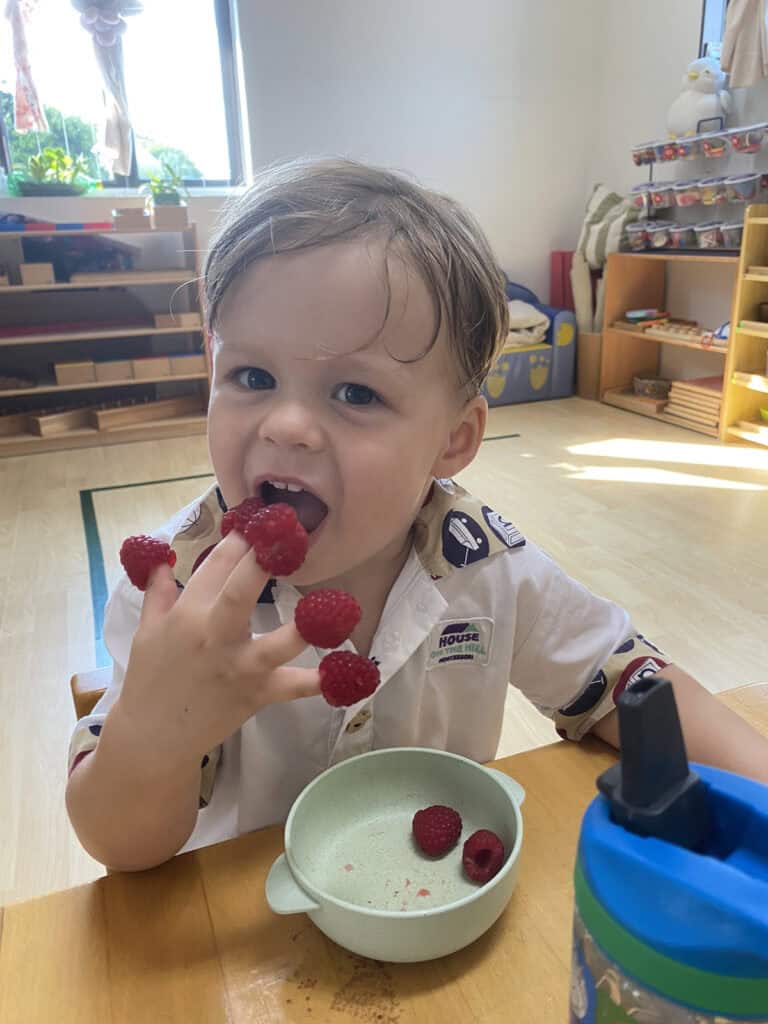
These activities support fine and gross motor development, improve hand-eye coordination, and foster independence. As children, slice bananas, pears and lemons to make a fruit salad, and serve themselves, they gain confidence and ownership of their food choices. Mealtimes also provide a natural opportunity to teach children about ingredients—where they come from and how they help our bodies thrive—turning daily routines into moments of learning and self-discovery, it would help them to build great connections with the food on their plates.
As food education becomes a natural part of the day, our preschoolers develop an appreciation for the vibrant colours, different textures, delicious flavours, and the feel-good energy that healthy food brings. This gentle introduction creates positive feelings around mealtimes and encourages them to make nourishing choices throughout their lives.
2. Making Food Fun and Meaningful
In our nurturing approach to teaching healthy eating to preschoolers, we use playful language to help children connect with healthy choices. For example, a teacher might say, “These crunchy carrots help your eyes see like superheroes in the night!”
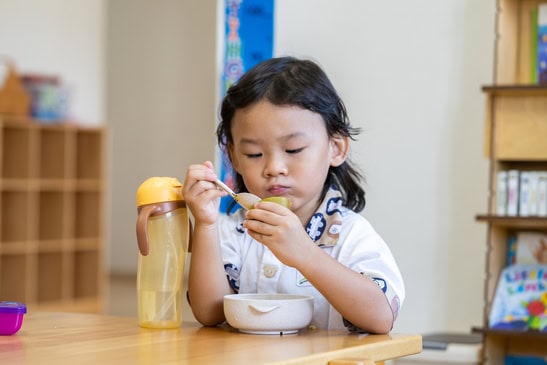
To deepen this joyful learning, we use books, songs, and child-sized utensils. These activities help reinforce the messages in a fun, engaging way that captures their curiosity during snack time and mealtime gatherings.
Our little explorers delight in discovering food groups through sensory activities like sorting colourful fruits and vegetables, matching foods to their natural origins, or planting seeds in our classroom garden helps build lasting connections between food, nature and wellbeing.
3. Shaping a Positive Environment Around Food
Just as the nutritious ingredients on a child’s plate nurture their growing body, the gentle atmosphere surrounding mealtimes shapes their relationship with food. A calm, unhurried setting encourages preschoolers to listen to their bodies—fostering mindfulness and healthy habits that blossom over time.
As part of our Practical Life curriculum, these shared mealtimes nurture social and emotional growth just as much as physical nourishment. We invite children to participate in setting the table to promote a sense of responsibility, independence, and respect. They’re invited to help set the table and assist with after-meal tasks(e.g. cleaning the place mat, placing the bowl &. cutleries as well as their water bottles ), cultivating responsibility, independence, and respect for others.
As they sit together, children practice the art of patience, make social connections, learn table manners, and enjoy their meals mindfully. Once they’re done, they are made to clean their space, sort out where the bowl, spoon or used tissue goes—an important lesson in caring for both themselves and the community.
4. Continuing The Nutritious Journey at Home
Building healthy eating habits doesn’t end at school—they’re most impactful when continued at home. When children see the same joyful, nourishing approach to food reflected in both environments, they become more confident and excited about meals that fuel their growth and learning.
Looking up healthy snacks for 4-year-olds is a great place to start, but lasting habits are built through daily repetition. Parents play an essential role in creating positive associations with food and mealtimes at home.
So how can parents and caregivers extend this habit beyond the walls of House on the Hill?
- Offer a colourful spread of healthy options for preschoolers, and give children the freedom to explore new tastes and textures at their own pace.
- Involve children in grocery shopping—let them choose fresh produce, then help prepare meals at home.
- Make mealtimes meaningful by eating together in a calm, screen-free mealtime environment that encourages connection.
When caring school and parents work together as a whole environment, children feel confident, curious and connected to what they eat.
Our Holistic Approach to Early Learning
At House on the Hill, we don’t just focus on what your child learns—we nurture the whole child. A key part of that journey is learning how to care for their body, so they have the energy, confidence, and joy to keep exploring the world around them.
To ensure every bite supports their well-being, we use only the highest quality produce to create balanced and nutritious meals for our growing children. Our meals are carefully developed with renowned nutritionist Ian Marber, and we are proudly certified by Singapore’s Health Promotion Board under the Healthy Meals in Pre-schools Programme (HMPP).
We use only fresh ingredients to craft balanced (No added salt and sugar, along with no powder or sauce), nutritious meals that support physical health, emotional wellbeing, and a love for learning.
If you’re interested in learning more about how our Montessori school experience supports healthy growth and lifelong habits, we invite you to explore our Mount Sophia Preschool, or read more about House on The Hill Preschool.

